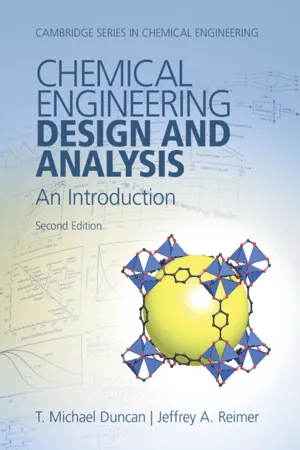
Chemical Engineering Design and Analysis
An Introduction
- English
- PDF
- Available on iOS & Android
About this book
This textbook puts design at the center of introducing students to the course in mass and energy balances in chemical engineering. Employers and accreditations increasingly stress the importance of design in the engineering curriculum, and design-driven analysis will motivate students to dig deeply into the key concepts of the field. The second edition has been completely revised and updated. It introduces the central steps in design and three methods of analysis: mathematical modeling, graphical methods, and dimensional analysis. Students learn how to apply engineering skills, such as how to simplify calculations through assumptions and approximations; how to verify calculations, significant figures, spreadsheets, graphing (standard, semi-log and log-log); and how to use data maps, in the contexts of contemporary chemical processes such as the hydrogen economy, petrochemical and biochemical processes, polymers, semiconductors, and pharmaceuticals.
Frequently asked questions
- Essential is ideal for learners and professionals who enjoy exploring a wide range of subjects. Access the Essential Library with 800,000+ trusted titles and best-sellers across business, personal growth, and the humanities. Includes unlimited reading time and Standard Read Aloud voice.
- Complete: Perfect for advanced learners and researchers needing full, unrestricted access. Unlock 1.4M+ books across hundreds of subjects, including academic and specialized titles. The Complete Plan also includes advanced features like Premium Read Aloud and Research Assistant.
Please note we cannot support devices running on iOS 13 and Android 7 or earlier. Learn more about using the app.
Information

Table of contents
- Cover
- Half-title
- Series information
- Title page
- Copyright information
- Dedication
- Brief Contents
- Contents
- Preface
- Acknowledgements
- 1 An Overview of Chemical Engineering
- 2 Chemical Process Design
- 3 Models Derived from Laws and Mathematical Analysis
- 4 Models Derived from Graphical Analysis
- 5 Dimensional Analysis and Dynamic Similarity
- 6 Transient-State Processes
- Appendix A List of Symbols
- Appendix B Units, Conversion Factors, and Physical Constants
- Appendix C Significant Figures
- Appendix D Log-Log Graph Paper
- Appendix E Mathematics, Mechanics, and Thermodynamics
- Appendix F Glossary of Chemical Engineering
- Index